Dental Equipment and Instruments
VerifiedAdded on 2021/04/17
|14
|3063
|64
AI Summary
The provided assignment discusses dental equipment, instruments, and personal care items used in the dental profession. It lists various categories such as hand instruments, restorative materials, and finishing burs, providing detailed information on their uses and applications. The document also references relevant literature and studies related to medical errors, caries classification, and healthcare-associated infections.
Contribute Materials
Your contribution can guide someone’s learning journey. Share your
documents today.
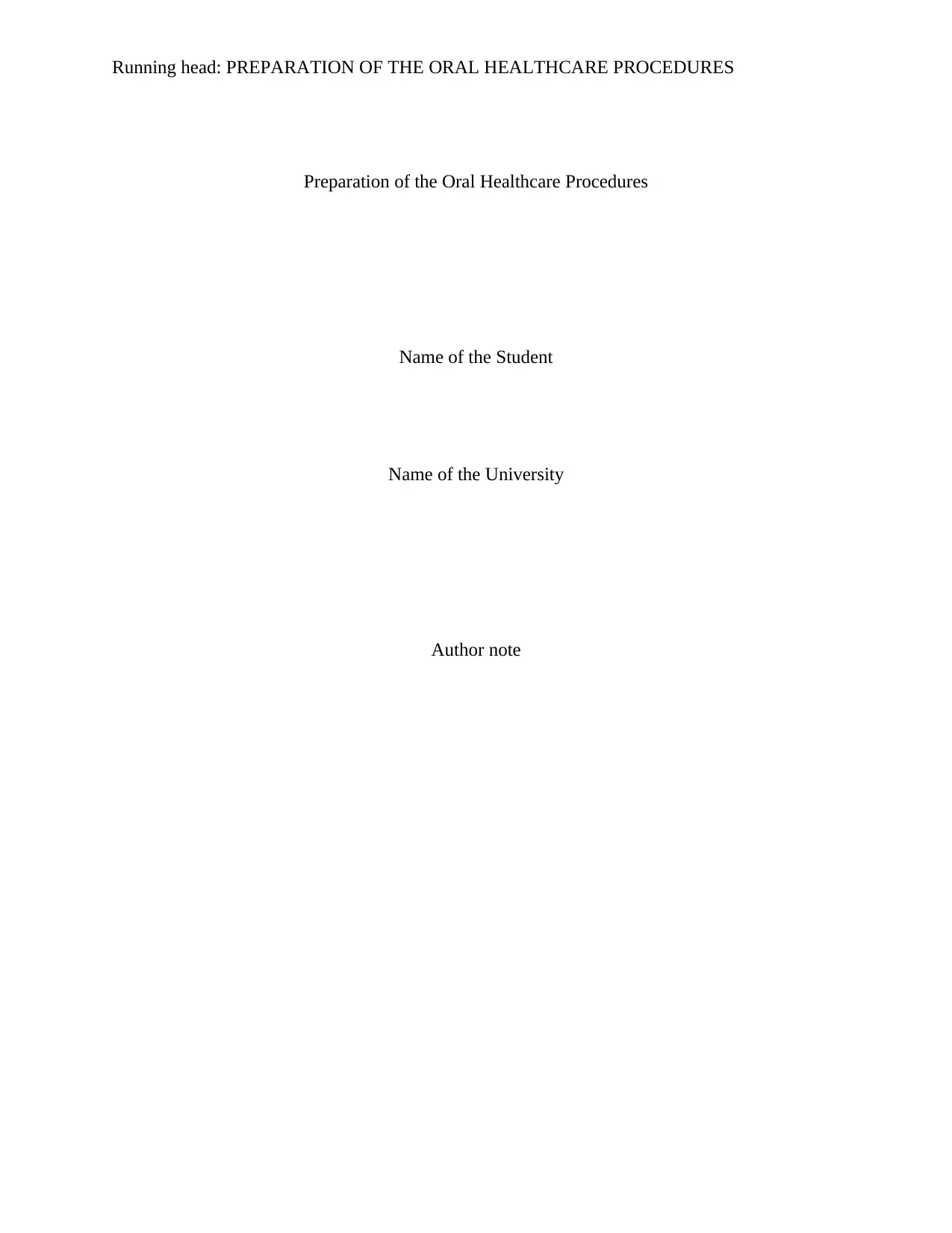
Running head: PREPARATION OF THE ORAL HEALTHCARE PROCEDURES
Preparation of the Oral Healthcare Procedures
Name of the Student
Name of the University
Author note
Preparation of the Oral Healthcare Procedures
Name of the Student
Name of the University
Author note
Secure Best Marks with AI Grader
Need help grading? Try our AI Grader for instant feedback on your assignments.
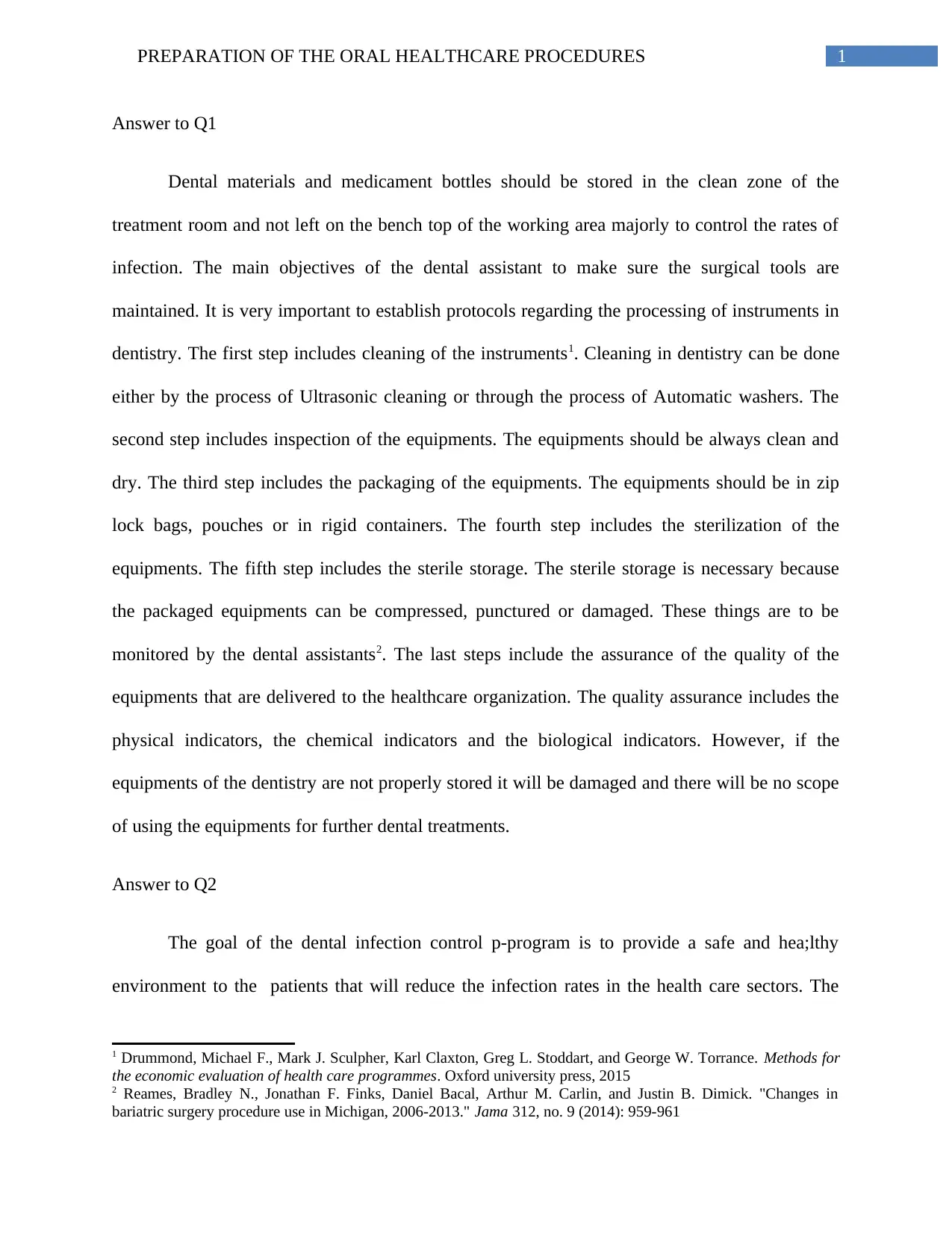
1PREPARATION OF THE ORAL HEALTHCARE PROCEDURES
Answer to Q1
Dental materials and medicament bottles should be stored in the clean zone of the
treatment room and not left on the bench top of the working area majorly to control the rates of
infection. The main objectives of the dental assistant to make sure the surgical tools are
maintained. It is very important to establish protocols regarding the processing of instruments in
dentistry. The first step includes cleaning of the instruments1. Cleaning in dentistry can be done
either by the process of Ultrasonic cleaning or through the process of Automatic washers. The
second step includes inspection of the equipments. The equipments should be always clean and
dry. The third step includes the packaging of the equipments. The equipments should be in zip
lock bags, pouches or in rigid containers. The fourth step includes the sterilization of the
equipments. The fifth step includes the sterile storage. The sterile storage is necessary because
the packaged equipments can be compressed, punctured or damaged. These things are to be
monitored by the dental assistants2. The last steps include the assurance of the quality of the
equipments that are delivered to the healthcare organization. The quality assurance includes the
physical indicators, the chemical indicators and the biological indicators. However, if the
equipments of the dentistry are not properly stored it will be damaged and there will be no scope
of using the equipments for further dental treatments.
Answer to Q2
The goal of the dental infection control p-program is to provide a safe and hea;lthy
environment to the patients that will reduce the infection rates in the health care sectors. The
1 Drummond, Michael F., Mark J. Sculpher, Karl Claxton, Greg L. Stoddart, and George W. Torrance. Methods for
the economic evaluation of health care programmes. Oxford university press, 2015
2 Reames, Bradley N., Jonathan F. Finks, Daniel Bacal, Arthur M. Carlin, and Justin B. Dimick. "Changes in
bariatric surgery procedure use in Michigan, 2006-2013." Jama 312, no. 9 (2014): 959-961
Answer to Q1
Dental materials and medicament bottles should be stored in the clean zone of the
treatment room and not left on the bench top of the working area majorly to control the rates of
infection. The main objectives of the dental assistant to make sure the surgical tools are
maintained. It is very important to establish protocols regarding the processing of instruments in
dentistry. The first step includes cleaning of the instruments1. Cleaning in dentistry can be done
either by the process of Ultrasonic cleaning or through the process of Automatic washers. The
second step includes inspection of the equipments. The equipments should be always clean and
dry. The third step includes the packaging of the equipments. The equipments should be in zip
lock bags, pouches or in rigid containers. The fourth step includes the sterilization of the
equipments. The fifth step includes the sterile storage. The sterile storage is necessary because
the packaged equipments can be compressed, punctured or damaged. These things are to be
monitored by the dental assistants2. The last steps include the assurance of the quality of the
equipments that are delivered to the healthcare organization. The quality assurance includes the
physical indicators, the chemical indicators and the biological indicators. However, if the
equipments of the dentistry are not properly stored it will be damaged and there will be no scope
of using the equipments for further dental treatments.
Answer to Q2
The goal of the dental infection control p-program is to provide a safe and hea;lthy
environment to the patients that will reduce the infection rates in the health care sectors. The
1 Drummond, Michael F., Mark J. Sculpher, Karl Claxton, Greg L. Stoddart, and George W. Torrance. Methods for
the economic evaluation of health care programmes. Oxford university press, 2015
2 Reames, Bradley N., Jonathan F. Finks, Daniel Bacal, Arthur M. Carlin, and Justin B. Dimick. "Changes in
bariatric surgery procedure use in Michigan, 2006-2013." Jama 312, no. 9 (2014): 959-961
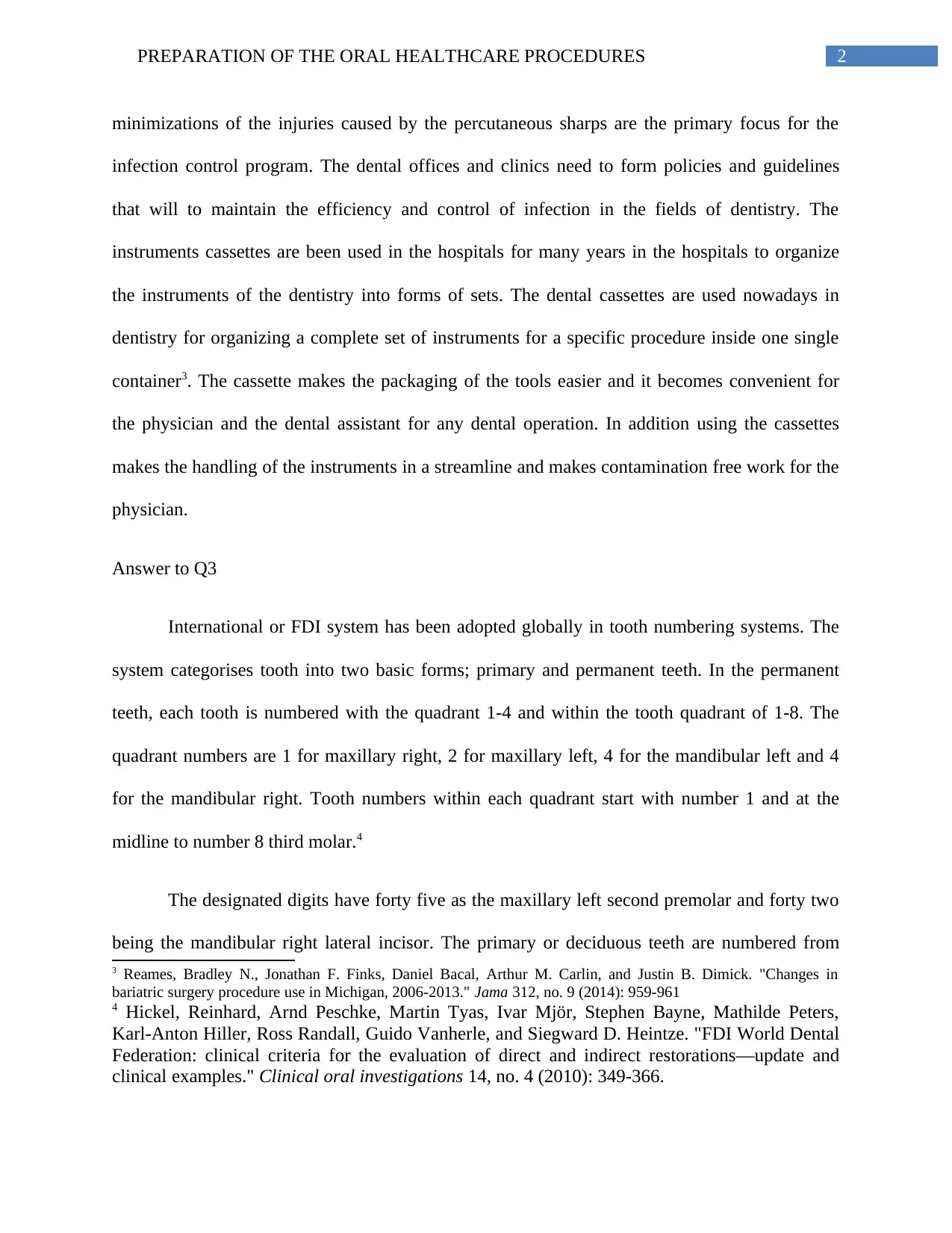
2PREPARATION OF THE ORAL HEALTHCARE PROCEDURES
minimizations of the injuries caused by the percutaneous sharps are the primary focus for the
infection control program. The dental offices and clinics need to form policies and guidelines
that will to maintain the efficiency and control of infection in the fields of dentistry. The
instruments cassettes are been used in the hospitals for many years in the hospitals to organize
the instruments of the dentistry into forms of sets. The dental cassettes are used nowadays in
dentistry for organizing a complete set of instruments for a specific procedure inside one single
container3. The cassette makes the packaging of the tools easier and it becomes convenient for
the physician and the dental assistant for any dental operation. In addition using the cassettes
makes the handling of the instruments in a streamline and makes contamination free work for the
physician.
Answer to Q3
International or FDI system has been adopted globally in tooth numbering systems. The
system categorises tooth into two basic forms; primary and permanent teeth. In the permanent
teeth, each tooth is numbered with the quadrant 1-4 and within the tooth quadrant of 1-8. The
quadrant numbers are 1 for maxillary right, 2 for maxillary left, 4 for the mandibular left and 4
for the mandibular right. Tooth numbers within each quadrant start with number 1 and at the
midline to number 8 third molar.4
The designated digits have forty five as the maxillary left second premolar and forty two
being the mandibular right lateral incisor. The primary or deciduous teeth are numbered from
3 Reames, Bradley N., Jonathan F. Finks, Daniel Bacal, Arthur M. Carlin, and Justin B. Dimick. "Changes in
bariatric surgery procedure use in Michigan, 2006-2013." Jama 312, no. 9 (2014): 959-961
4 Hickel, Reinhard, Arnd Peschke, Martin Tyas, Ivar Mjör, Stephen Bayne, Mathilde Peters,
Karl-Anton Hiller, Ross Randall, Guido Vanherle, and Siegward D. Heintze. "FDI World Dental
Federation: clinical criteria for the evaluation of direct and indirect restorations—update and
clinical examples." Clinical oral investigations 14, no. 4 (2010): 349-366.
minimizations of the injuries caused by the percutaneous sharps are the primary focus for the
infection control program. The dental offices and clinics need to form policies and guidelines
that will to maintain the efficiency and control of infection in the fields of dentistry. The
instruments cassettes are been used in the hospitals for many years in the hospitals to organize
the instruments of the dentistry into forms of sets. The dental cassettes are used nowadays in
dentistry for organizing a complete set of instruments for a specific procedure inside one single
container3. The cassette makes the packaging of the tools easier and it becomes convenient for
the physician and the dental assistant for any dental operation. In addition using the cassettes
makes the handling of the instruments in a streamline and makes contamination free work for the
physician.
Answer to Q3
International or FDI system has been adopted globally in tooth numbering systems. The
system categorises tooth into two basic forms; primary and permanent teeth. In the permanent
teeth, each tooth is numbered with the quadrant 1-4 and within the tooth quadrant of 1-8. The
quadrant numbers are 1 for maxillary right, 2 for maxillary left, 4 for the mandibular left and 4
for the mandibular right. Tooth numbers within each quadrant start with number 1 and at the
midline to number 8 third molar.4
The designated digits have forty five as the maxillary left second premolar and forty two
being the mandibular right lateral incisor. The primary or deciduous teeth are numbered from
3 Reames, Bradley N., Jonathan F. Finks, Daniel Bacal, Arthur M. Carlin, and Justin B. Dimick. "Changes in
bariatric surgery procedure use in Michigan, 2006-2013." Jama 312, no. 9 (2014): 959-961
4 Hickel, Reinhard, Arnd Peschke, Martin Tyas, Ivar Mjör, Stephen Bayne, Mathilde Peters,
Karl-Anton Hiller, Ross Randall, Guido Vanherle, and Siegward D. Heintze. "FDI World Dental
Federation: clinical criteria for the evaluation of direct and indirect restorations—update and
clinical examples." Clinical oral investigations 14, no. 4 (2010): 349-366.
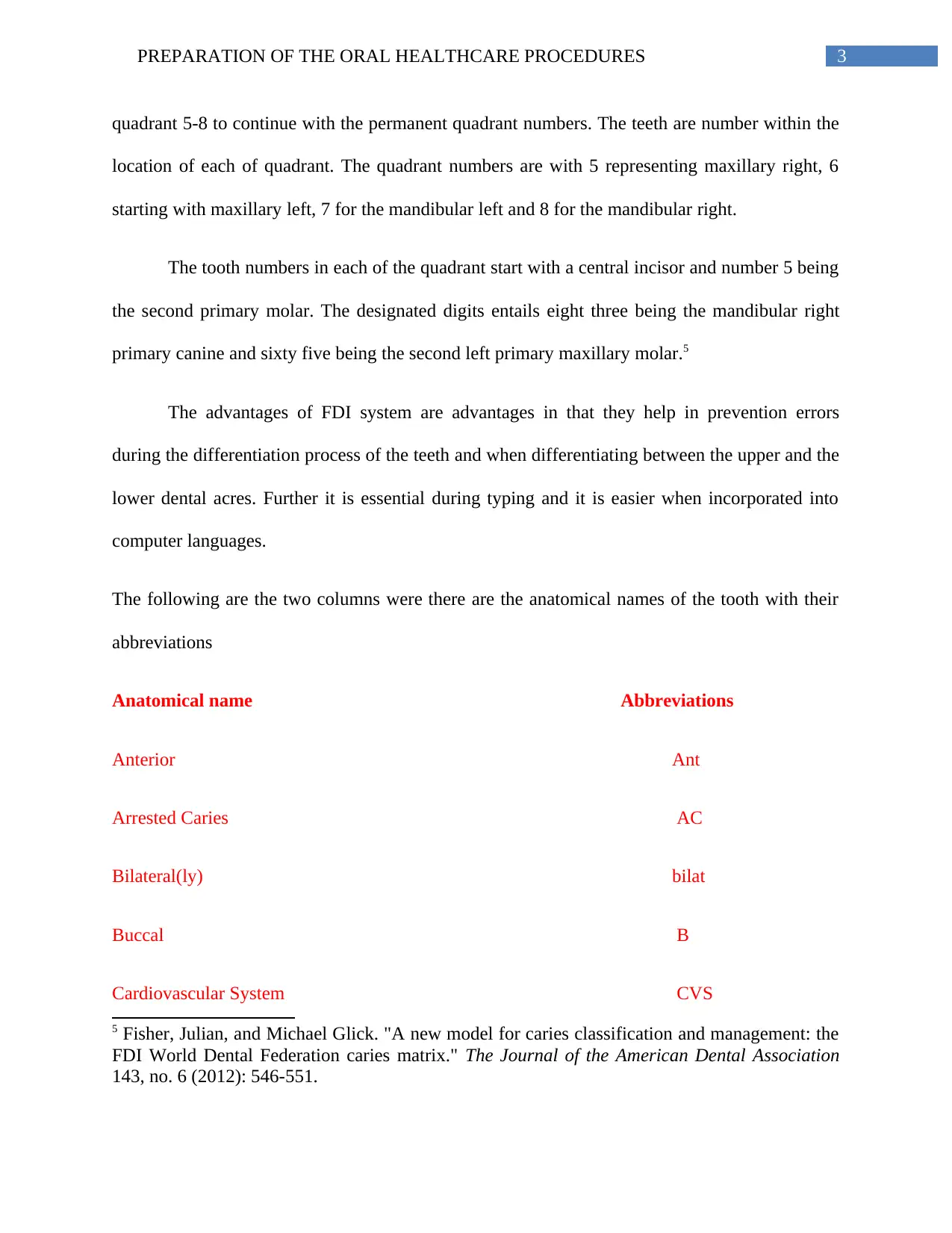
3PREPARATION OF THE ORAL HEALTHCARE PROCEDURES
quadrant 5-8 to continue with the permanent quadrant numbers. The teeth are number within the
location of each of quadrant. The quadrant numbers are with 5 representing maxillary right, 6
starting with maxillary left, 7 for the mandibular left and 8 for the mandibular right.
The tooth numbers in each of the quadrant start with a central incisor and number 5 being
the second primary molar. The designated digits entails eight three being the mandibular right
primary canine and sixty five being the second left primary maxillary molar.5
The advantages of FDI system are advantages in that they help in prevention errors
during the differentiation process of the teeth and when differentiating between the upper and the
lower dental acres. Further it is essential during typing and it is easier when incorporated into
computer languages.
The following are the two columns were there are the anatomical names of the tooth with their
abbreviations
Anatomical name Abbreviations
Anterior Ant
Arrested Caries AC
Bilateral(ly) bilat
Buccal B
Cardiovascular System CVS
5 Fisher, Julian, and Michael Glick. "A new model for caries classification and management: the
FDI World Dental Federation caries matrix." The Journal of the American Dental Association
143, no. 6 (2012): 546-551.
quadrant 5-8 to continue with the permanent quadrant numbers. The teeth are number within the
location of each of quadrant. The quadrant numbers are with 5 representing maxillary right, 6
starting with maxillary left, 7 for the mandibular left and 8 for the mandibular right.
The tooth numbers in each of the quadrant start with a central incisor and number 5 being
the second primary molar. The designated digits entails eight three being the mandibular right
primary canine and sixty five being the second left primary maxillary molar.5
The advantages of FDI system are advantages in that they help in prevention errors
during the differentiation process of the teeth and when differentiating between the upper and the
lower dental acres. Further it is essential during typing and it is easier when incorporated into
computer languages.
The following are the two columns were there are the anatomical names of the tooth with their
abbreviations
Anatomical name Abbreviations
Anterior Ant
Arrested Caries AC
Bilateral(ly) bilat
Buccal B
Cardiovascular System CVS
5 Fisher, Julian, and Michael Glick. "A new model for caries classification and management: the
FDI World Dental Federation caries matrix." The Journal of the American Dental Association
143, no. 6 (2012): 546-551.
Secure Best Marks with AI Grader
Need help grading? Try our AI Grader for instant feedback on your assignments.
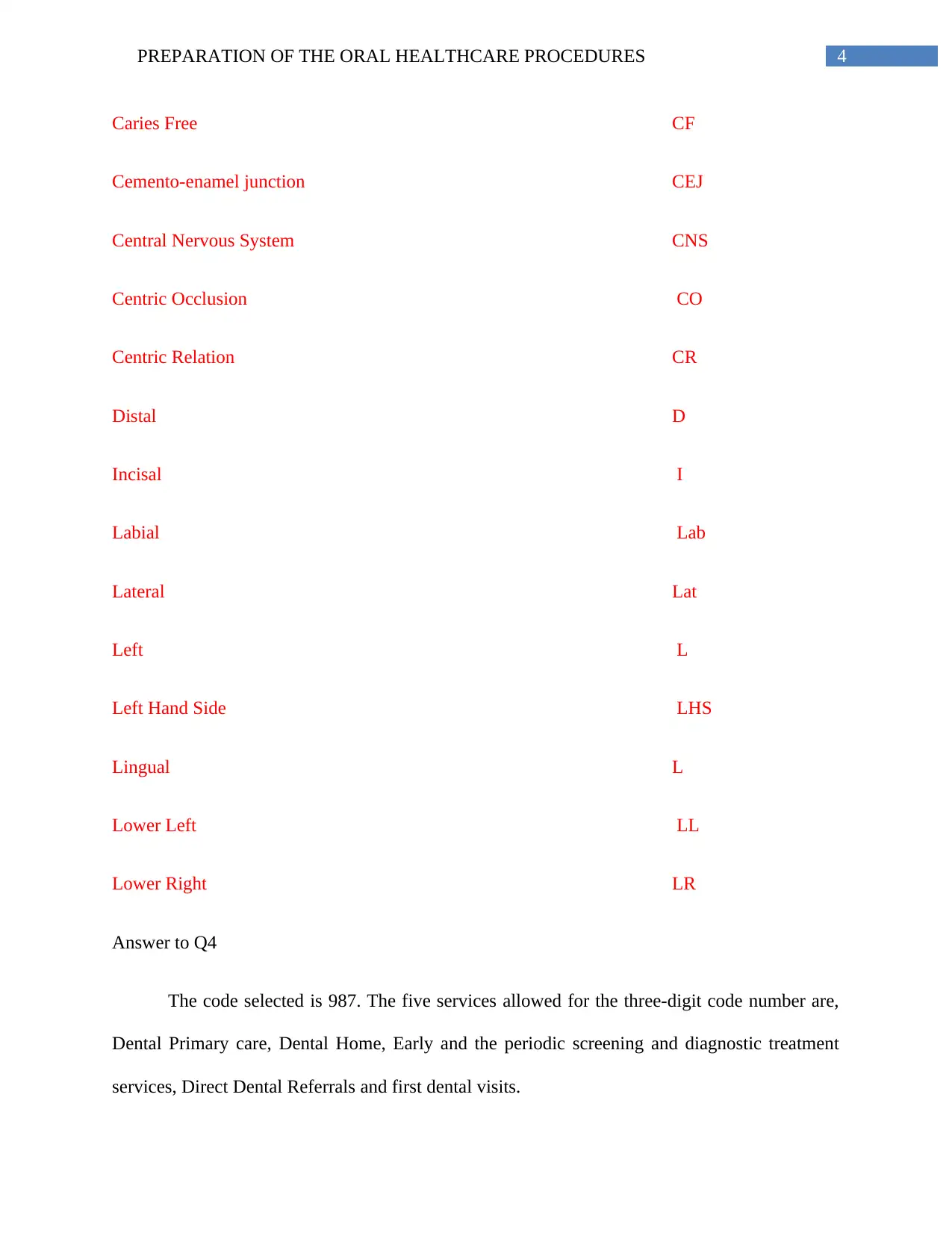
4PREPARATION OF THE ORAL HEALTHCARE PROCEDURES
Caries Free CF
Cemento-enamel junction CEJ
Central Nervous System CNS
Centric Occlusion CO
Centric Relation CR
Distal D
Incisal I
Labial Lab
Lateral Lat
Left L
Left Hand Side LHS
Lingual L
Lower Left LL
Lower Right LR
Answer to Q4
The code selected is 987. The five services allowed for the three-digit code number are,
Dental Primary care, Dental Home, Early and the periodic screening and diagnostic treatment
services, Direct Dental Referrals and first dental visits.
Caries Free CF
Cemento-enamel junction CEJ
Central Nervous System CNS
Centric Occlusion CO
Centric Relation CR
Distal D
Incisal I
Labial Lab
Lateral Lat
Left L
Left Hand Side LHS
Lingual L
Lower Left LL
Lower Right LR
Answer to Q4
The code selected is 987. The five services allowed for the three-digit code number are,
Dental Primary care, Dental Home, Early and the periodic screening and diagnostic treatment
services, Direct Dental Referrals and first dental visits.
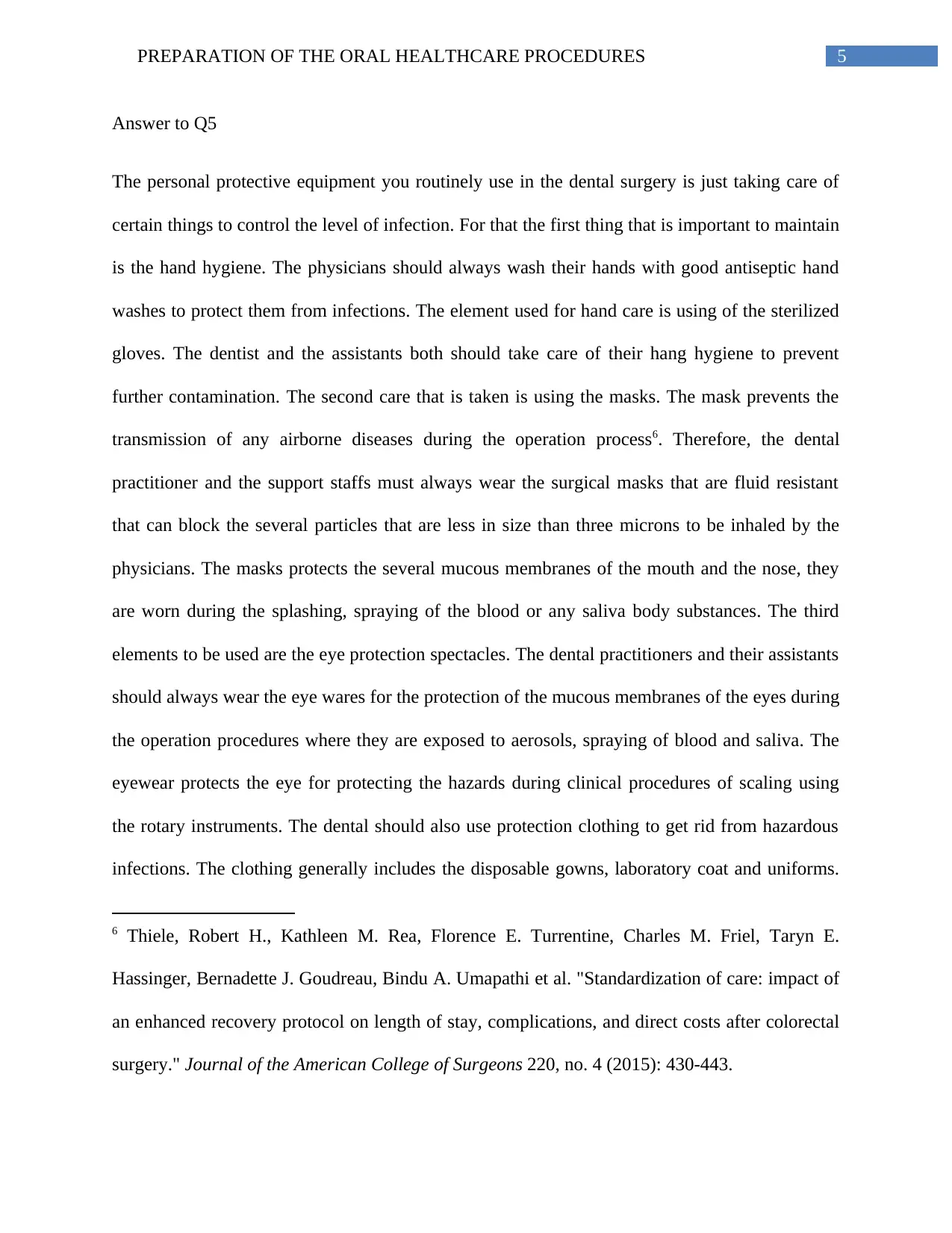
5PREPARATION OF THE ORAL HEALTHCARE PROCEDURES
Answer to Q5
The personal protective equipment you routinely use in the dental surgery is just taking care of
certain things to control the level of infection. For that the first thing that is important to maintain
is the hand hygiene. The physicians should always wash their hands with good antiseptic hand
washes to protect them from infections. The element used for hand care is using of the sterilized
gloves. The dentist and the assistants both should take care of their hang hygiene to prevent
further contamination. The second care that is taken is using the masks. The mask prevents the
transmission of any airborne diseases during the operation process6. Therefore, the dental
practitioner and the support staffs must always wear the surgical masks that are fluid resistant
that can block the several particles that are less in size than three microns to be inhaled by the
physicians. The masks protects the several mucous membranes of the mouth and the nose, they
are worn during the splashing, spraying of the blood or any saliva body substances. The third
elements to be used are the eye protection spectacles. The dental practitioners and their assistants
should always wear the eye wares for the protection of the mucous membranes of the eyes during
the operation procedures where they are exposed to aerosols, spraying of blood and saliva. The
eyewear protects the eye for protecting the hazards during clinical procedures of scaling using
the rotary instruments. The dental should also use protection clothing to get rid from hazardous
infections. The clothing generally includes the disposable gowns, laboratory coat and uniforms.
6 Thiele, Robert H., Kathleen M. Rea, Florence E. Turrentine, Charles M. Friel, Taryn E.
Hassinger, Bernadette J. Goudreau, Bindu A. Umapathi et al. "Standardization of care: impact of
an enhanced recovery protocol on length of stay, complications, and direct costs after colorectal
surgery." Journal of the American College of Surgeons 220, no. 4 (2015): 430-443.
Answer to Q5
The personal protective equipment you routinely use in the dental surgery is just taking care of
certain things to control the level of infection. For that the first thing that is important to maintain
is the hand hygiene. The physicians should always wash their hands with good antiseptic hand
washes to protect them from infections. The element used for hand care is using of the sterilized
gloves. The dentist and the assistants both should take care of their hang hygiene to prevent
further contamination. The second care that is taken is using the masks. The mask prevents the
transmission of any airborne diseases during the operation process6. Therefore, the dental
practitioner and the support staffs must always wear the surgical masks that are fluid resistant
that can block the several particles that are less in size than three microns to be inhaled by the
physicians. The masks protects the several mucous membranes of the mouth and the nose, they
are worn during the splashing, spraying of the blood or any saliva body substances. The third
elements to be used are the eye protection spectacles. The dental practitioners and their assistants
should always wear the eye wares for the protection of the mucous membranes of the eyes during
the operation procedures where they are exposed to aerosols, spraying of blood and saliva. The
eyewear protects the eye for protecting the hazards during clinical procedures of scaling using
the rotary instruments. The dental should also use protection clothing to get rid from hazardous
infections. The clothing generally includes the disposable gowns, laboratory coat and uniforms.
6 Thiele, Robert H., Kathleen M. Rea, Florence E. Turrentine, Charles M. Friel, Taryn E.
Hassinger, Bernadette J. Goudreau, Bindu A. Umapathi et al. "Standardization of care: impact of
an enhanced recovery protocol on length of stay, complications, and direct costs after colorectal
surgery." Journal of the American College of Surgeons 220, no. 4 (2015): 430-443.
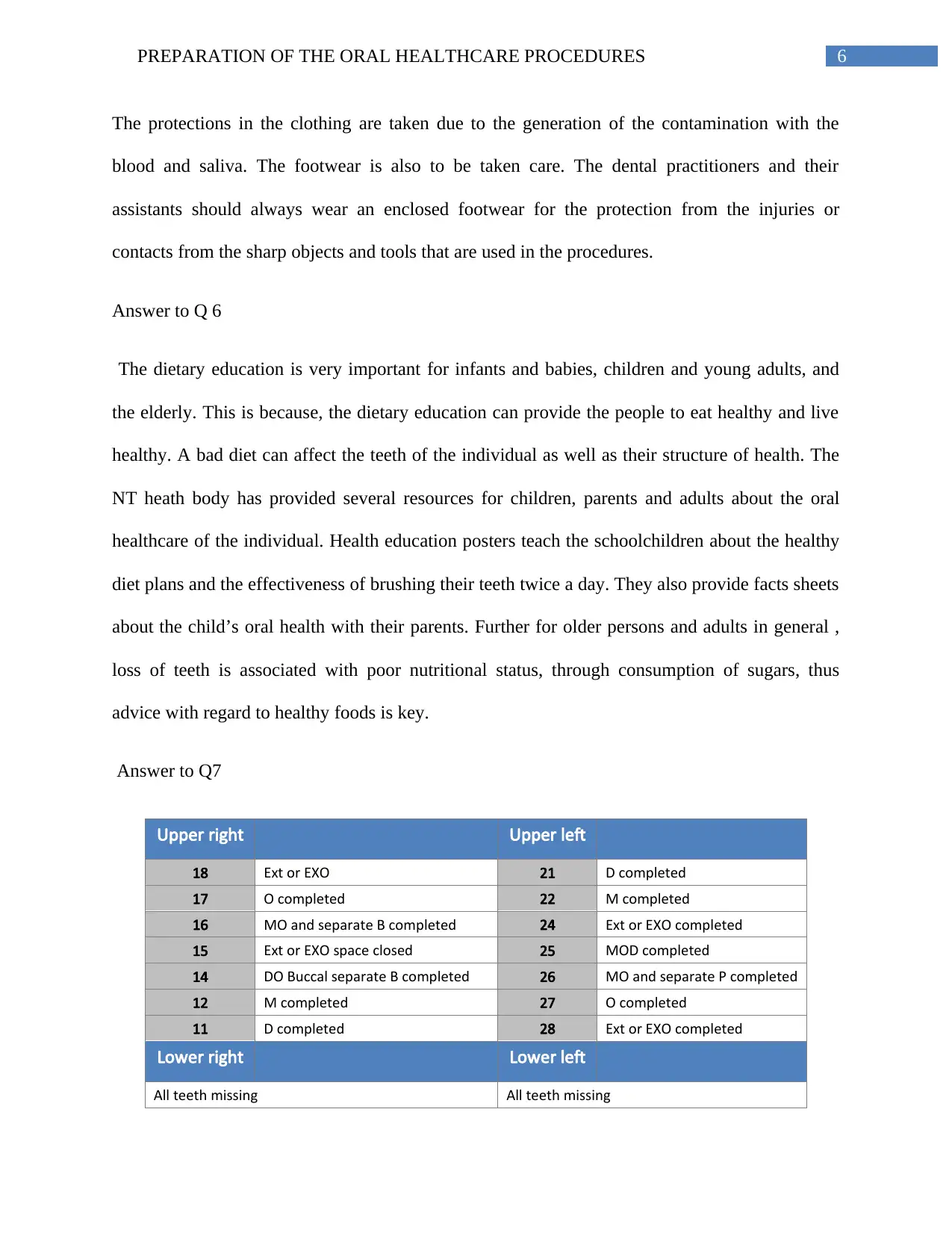
6PREPARATION OF THE ORAL HEALTHCARE PROCEDURES
The protections in the clothing are taken due to the generation of the contamination with the
blood and saliva. The footwear is also to be taken care. The dental practitioners and their
assistants should always wear an enclosed footwear for the protection from the injuries or
contacts from the sharp objects and tools that are used in the procedures.
Answer to Q 6
The dietary education is very important for infants and babies, children and young adults, and
the elderly. This is because, the dietary education can provide the people to eat healthy and live
healthy. A bad diet can affect the teeth of the individual as well as their structure of health. The
NT heath body has provided several resources for children, parents and adults about the oral
healthcare of the individual. Health education posters teach the schoolchildren about the healthy
diet plans and the effectiveness of brushing their teeth twice a day. They also provide facts sheets
about the child’s oral health with their parents. Further for older persons and adults in general ,
loss of teeth is associated with poor nutritional status, through consumption of sugars, thus
advice with regard to healthy foods is key.
Answer to Q7
Upper right Upper left
18 Ext or EXO 21 D completed
17 O completed 22 M completed
16 MO and separate B completed 24 Ext or EXO completed
15 Ext or EXO space closed 25 MOD completed
14 DO Buccal separate B completed 26 MO and separate P completed
12 M completed 27 O completed
11 D completed 28 Ext or EXO completed
Lower right Lower left
All teeth missing All teeth missing
The protections in the clothing are taken due to the generation of the contamination with the
blood and saliva. The footwear is also to be taken care. The dental practitioners and their
assistants should always wear an enclosed footwear for the protection from the injuries or
contacts from the sharp objects and tools that are used in the procedures.
Answer to Q 6
The dietary education is very important for infants and babies, children and young adults, and
the elderly. This is because, the dietary education can provide the people to eat healthy and live
healthy. A bad diet can affect the teeth of the individual as well as their structure of health. The
NT heath body has provided several resources for children, parents and adults about the oral
healthcare of the individual. Health education posters teach the schoolchildren about the healthy
diet plans and the effectiveness of brushing their teeth twice a day. They also provide facts sheets
about the child’s oral health with their parents. Further for older persons and adults in general ,
loss of teeth is associated with poor nutritional status, through consumption of sugars, thus
advice with regard to healthy foods is key.
Answer to Q7
Upper right Upper left
18 Ext or EXO 21 D completed
17 O completed 22 M completed
16 MO and separate B completed 24 Ext or EXO completed
15 Ext or EXO space closed 25 MOD completed
14 DO Buccal separate B completed 26 MO and separate P completed
12 M completed 27 O completed
11 D completed 28 Ext or EXO completed
Lower right Lower left
All teeth missing All teeth missing
Paraphrase This Document
Need a fresh take? Get an instant paraphrase of this document with our AI Paraphraser
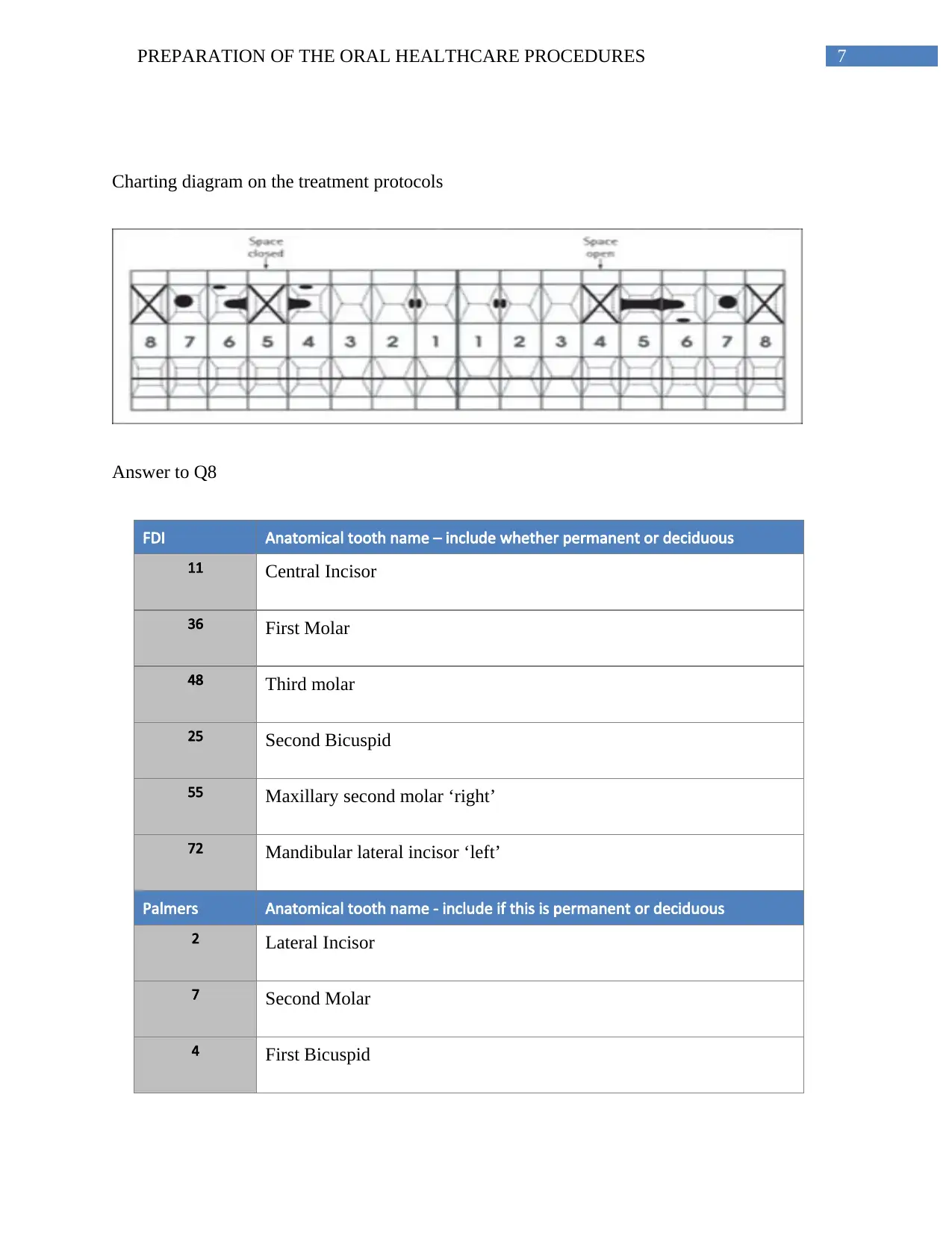
7PREPARATION OF THE ORAL HEALTHCARE PROCEDURES
Charting diagram on the treatment protocols
Answer to Q8
FDI Anatomical tooth name – include whether permanent or deciduous
11 Central Incisor
36 First Molar
48 Third molar
25 Second Bicuspid
55 Maxillary second molar ‘right’
72 Mandibular lateral incisor ‘left’
Palmers Anatomical tooth name - include if this is permanent or deciduous
2 Lateral Incisor
7 Second Molar
4 First Bicuspid
Charting diagram on the treatment protocols
Answer to Q8
FDI Anatomical tooth name – include whether permanent or deciduous
11 Central Incisor
36 First Molar
48 Third molar
25 Second Bicuspid
55 Maxillary second molar ‘right’
72 Mandibular lateral incisor ‘left’
Palmers Anatomical tooth name - include if this is permanent or deciduous
2 Lateral Incisor
7 Second Molar
4 First Bicuspid
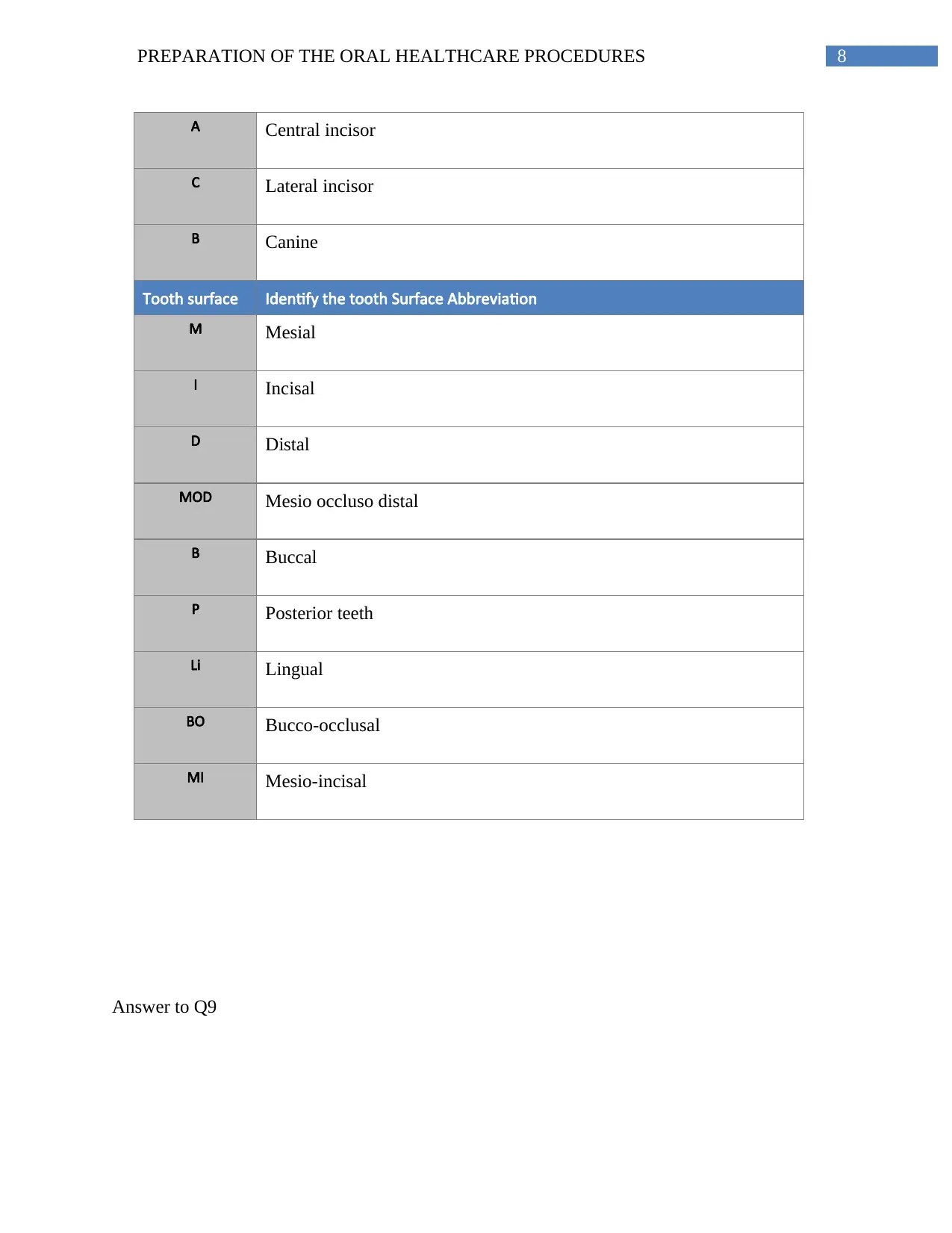
8PREPARATION OF THE ORAL HEALTHCARE PROCEDURES
A Central incisor
C Lateral incisor
B Canine
Tooth surface Identify the tooth Surface Abbreviation
M Mesial
I Incisal
D Distal
MOD Mesio occluso distal
B Buccal
P Posterior teeth
Li Lingual
BO Bucco-occlusal
MI Mesio-incisal
Answer to Q9
A Central incisor
C Lateral incisor
B Canine
Tooth surface Identify the tooth Surface Abbreviation
M Mesial
I Incisal
D Distal
MOD Mesio occluso distal
B Buccal
P Posterior teeth
Li Lingual
BO Bucco-occlusal
MI Mesio-incisal
Answer to Q9
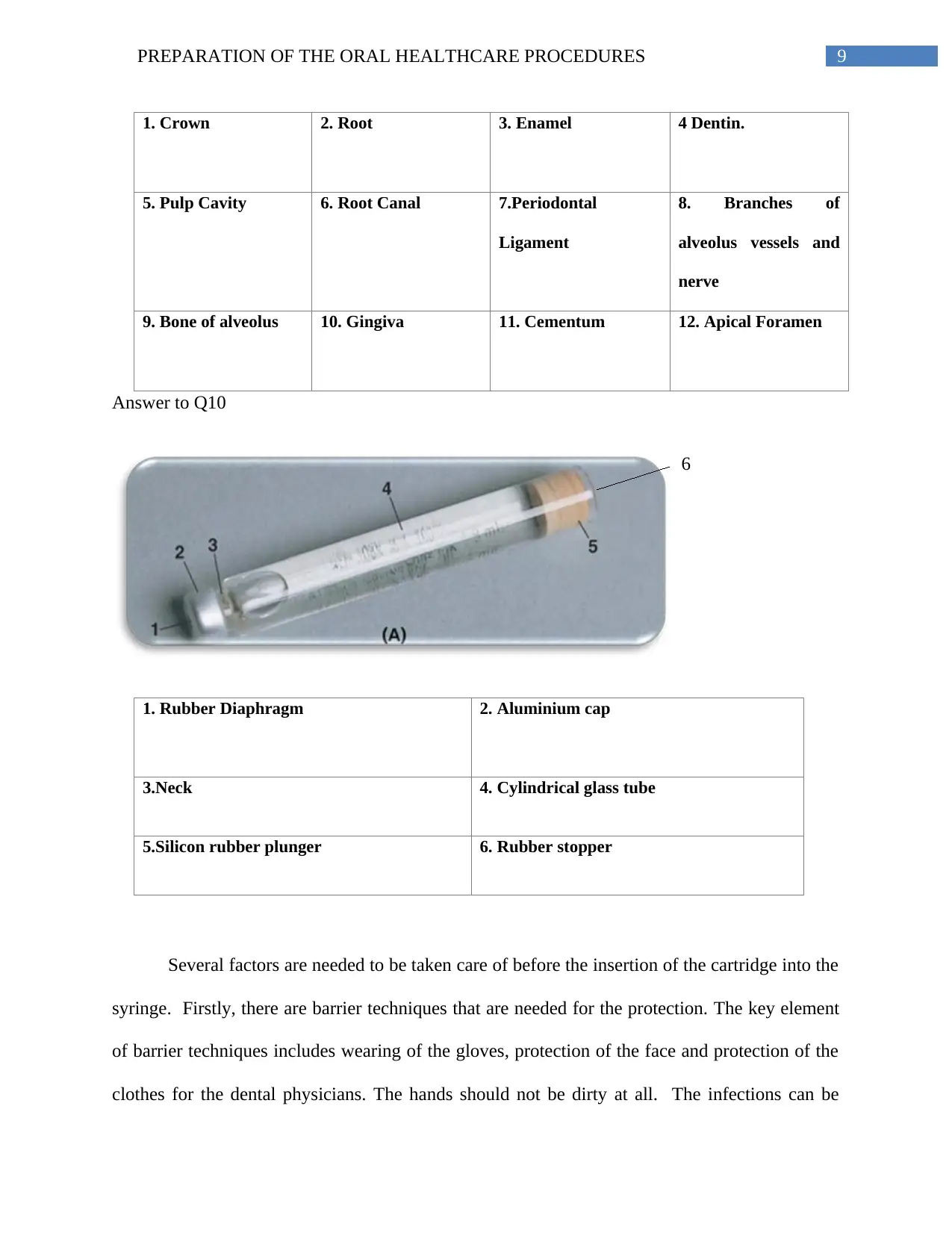
9PREPARATION OF THE ORAL HEALTHCARE PROCEDURES
1. Crown 2. Root 3. Enamel 4 Dentin.
5. Pulp Cavity 6. Root Canal 7.Periodontal
Ligament
8. Branches of
alveolus vessels and
nerve
9. Bone of alveolus 10. Gingiva 11. Cementum 12. Apical Foramen
Answer to Q10
1. Rubber Diaphragm 2. Aluminium cap
3.Neck 4. Cylindrical glass tube
5.Silicon rubber plunger 6. Rubber stopper
Several factors are needed to be taken care of before the insertion of the cartridge into the
syringe. Firstly, there are barrier techniques that are needed for the protection. The key element
of barrier techniques includes wearing of the gloves, protection of the face and protection of the
clothes for the dental physicians. The hands should not be dirty at all. The infections can be
6
1. Crown 2. Root 3. Enamel 4 Dentin.
5. Pulp Cavity 6. Root Canal 7.Periodontal
Ligament
8. Branches of
alveolus vessels and
nerve
9. Bone of alveolus 10. Gingiva 11. Cementum 12. Apical Foramen
Answer to Q10
1. Rubber Diaphragm 2. Aluminium cap
3.Neck 4. Cylindrical glass tube
5.Silicon rubber plunger 6. Rubber stopper
Several factors are needed to be taken care of before the insertion of the cartridge into the
syringe. Firstly, there are barrier techniques that are needed for the protection. The key element
of barrier techniques includes wearing of the gloves, protection of the face and protection of the
clothes for the dental physicians. The hands should not be dirty at all. The infections can be
6
Secure Best Marks with AI Grader
Need help grading? Try our AI Grader for instant feedback on your assignments.
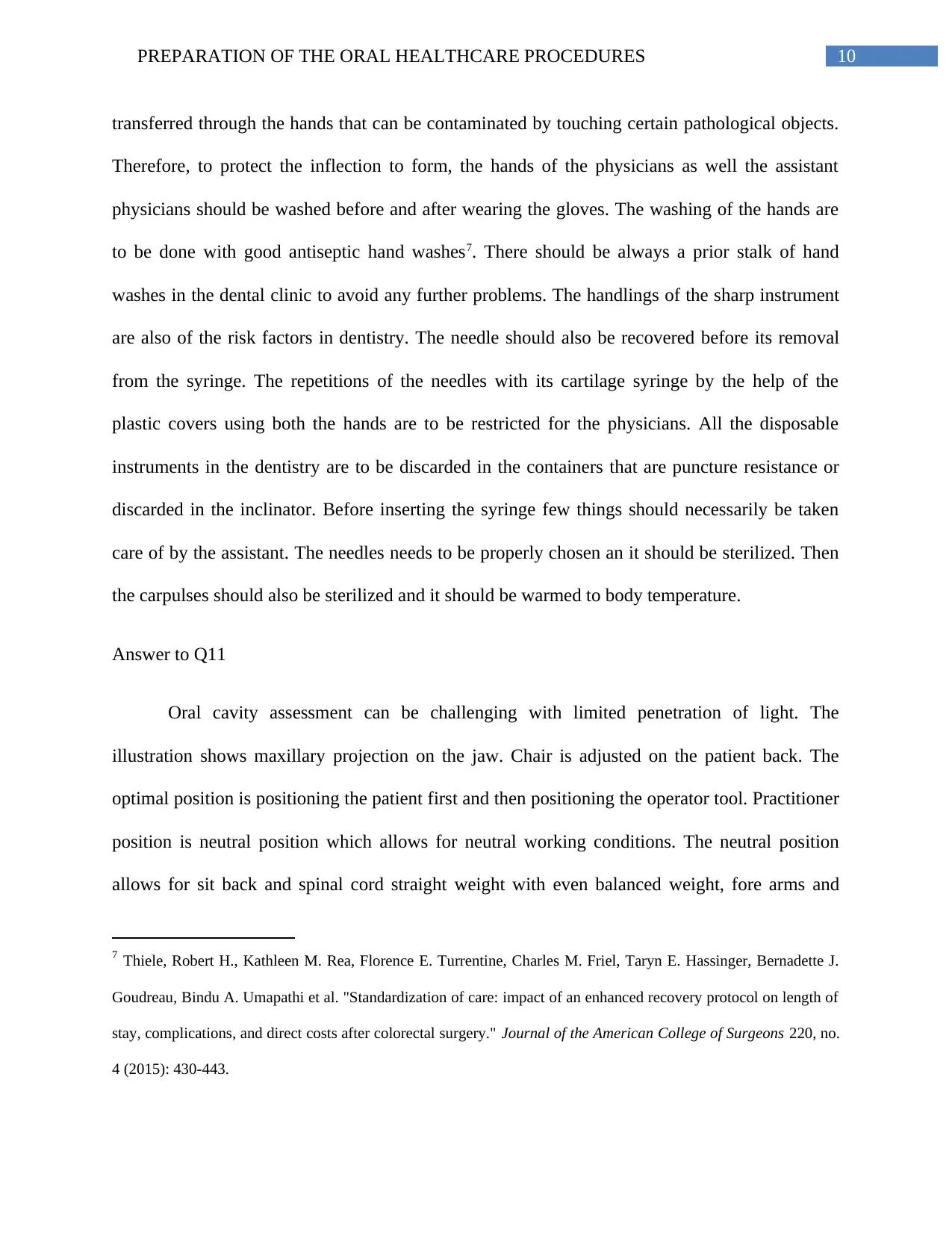
10PREPARATION OF THE ORAL HEALTHCARE PROCEDURES
transferred through the hands that can be contaminated by touching certain pathological objects.
Therefore, to protect the inflection to form, the hands of the physicians as well the assistant
physicians should be washed before and after wearing the gloves. The washing of the hands are
to be done with good antiseptic hand washes7. There should be always a prior stalk of hand
washes in the dental clinic to avoid any further problems. The handlings of the sharp instrument
are also of the risk factors in dentistry. The needle should also be recovered before its removal
from the syringe. The repetitions of the needles with its cartilage syringe by the help of the
plastic covers using both the hands are to be restricted for the physicians. All the disposable
instruments in the dentistry are to be discarded in the containers that are puncture resistance or
discarded in the inclinator. Before inserting the syringe few things should necessarily be taken
care of by the assistant. The needles needs to be properly chosen an it should be sterilized. Then
the carpulses should also be sterilized and it should be warmed to body temperature.
Answer to Q11
Oral cavity assessment can be challenging with limited penetration of light. The
illustration shows maxillary projection on the jaw. Chair is adjusted on the patient back. The
optimal position is positioning the patient first and then positioning the operator tool. Practitioner
position is neutral position which allows for neutral working conditions. The neutral position
allows for sit back and spinal cord straight weight with even balanced weight, fore arms and
7 Thiele, Robert H., Kathleen M. Rea, Florence E. Turrentine, Charles M. Friel, Taryn E. Hassinger, Bernadette J.
Goudreau, Bindu A. Umapathi et al. "Standardization of care: impact of an enhanced recovery protocol on length of
stay, complications, and direct costs after colorectal surgery." Journal of the American College of Surgeons 220, no.
4 (2015): 430-443.
transferred through the hands that can be contaminated by touching certain pathological objects.
Therefore, to protect the inflection to form, the hands of the physicians as well the assistant
physicians should be washed before and after wearing the gloves. The washing of the hands are
to be done with good antiseptic hand washes7. There should be always a prior stalk of hand
washes in the dental clinic to avoid any further problems. The handlings of the sharp instrument
are also of the risk factors in dentistry. The needle should also be recovered before its removal
from the syringe. The repetitions of the needles with its cartilage syringe by the help of the
plastic covers using both the hands are to be restricted for the physicians. All the disposable
instruments in the dentistry are to be discarded in the containers that are puncture resistance or
discarded in the inclinator. Before inserting the syringe few things should necessarily be taken
care of by the assistant. The needles needs to be properly chosen an it should be sterilized. Then
the carpulses should also be sterilized and it should be warmed to body temperature.
Answer to Q11
Oral cavity assessment can be challenging with limited penetration of light. The
illustration shows maxillary projection on the jaw. Chair is adjusted on the patient back. The
optimal position is positioning the patient first and then positioning the operator tool. Practitioner
position is neutral position which allows for neutral working conditions. The neutral position
allows for sit back and spinal cord straight weight with even balanced weight, fore arms and
7 Thiele, Robert H., Kathleen M. Rea, Florence E. Turrentine, Charles M. Friel, Taryn E. Hassinger, Bernadette J.
Goudreau, Bindu A. Umapathi et al. "Standardization of care: impact of an enhanced recovery protocol on length of
stay, complications, and direct costs after colorectal surgery." Journal of the American College of Surgeons 220, no.
4 (2015): 430-443.
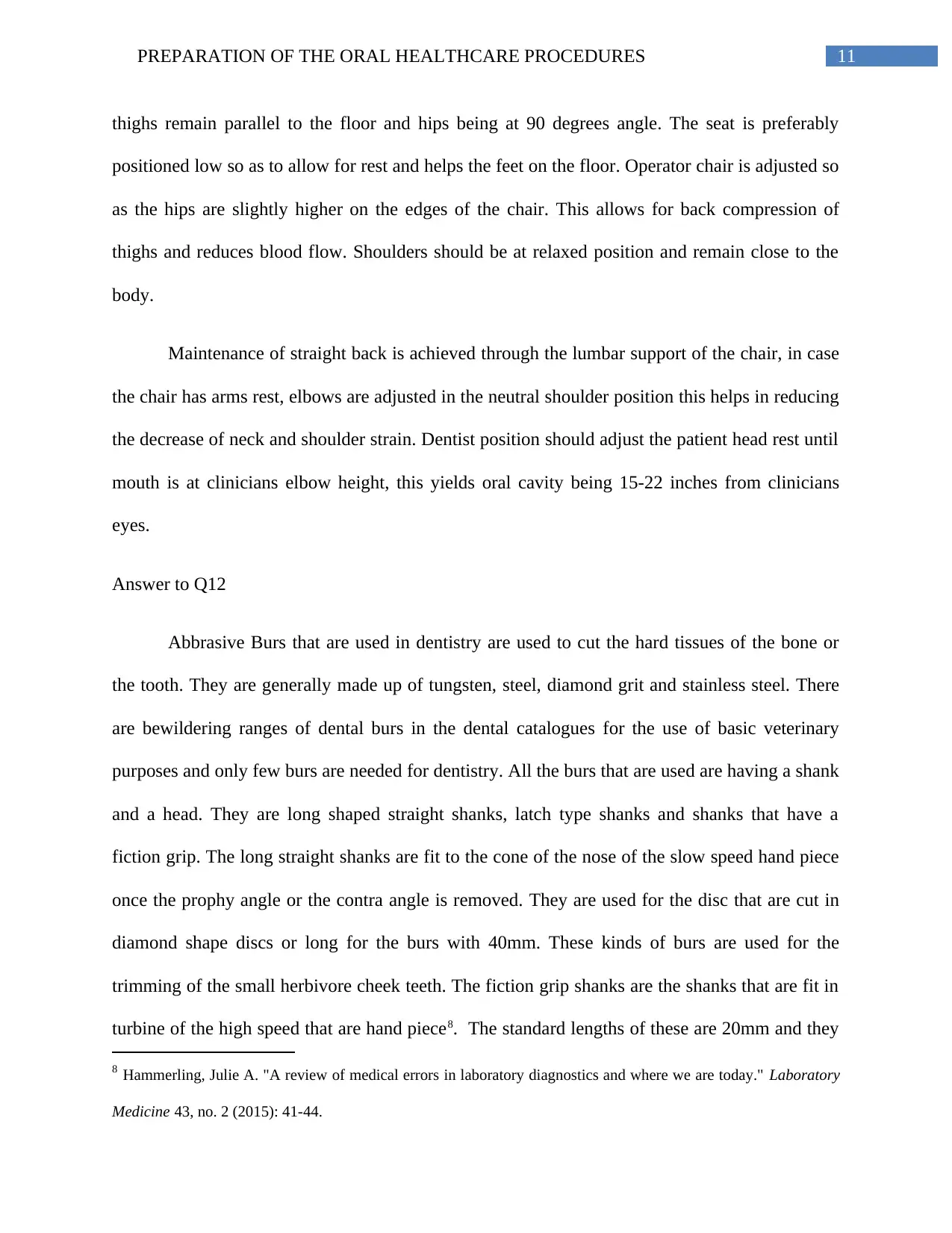
11PREPARATION OF THE ORAL HEALTHCARE PROCEDURES
thighs remain parallel to the floor and hips being at 90 degrees angle. The seat is preferably
positioned low so as to allow for rest and helps the feet on the floor. Operator chair is adjusted so
as the hips are slightly higher on the edges of the chair. This allows for back compression of
thighs and reduces blood flow. Shoulders should be at relaxed position and remain close to the
body.
Maintenance of straight back is achieved through the lumbar support of the chair, in case
the chair has arms rest, elbows are adjusted in the neutral shoulder position this helps in reducing
the decrease of neck and shoulder strain. Dentist position should adjust the patient head rest until
mouth is at clinicians elbow height, this yields oral cavity being 15-22 inches from clinicians
eyes.
Answer to Q12
Abbrasive Burs that are used in dentistry are used to cut the hard tissues of the bone or
the tooth. They are generally made up of tungsten, steel, diamond grit and stainless steel. There
are bewildering ranges of dental burs in the dental catalogues for the use of basic veterinary
purposes and only few burs are needed for dentistry. All the burs that are used are having a shank
and a head. They are long shaped straight shanks, latch type shanks and shanks that have a
fiction grip. The long straight shanks are fit to the cone of the nose of the slow speed hand piece
once the prophy angle or the contra angle is removed. They are used for the disc that are cut in
diamond shape discs or long for the burs with 40mm. These kinds of burs are used for the
trimming of the small herbivore cheek teeth. The fiction grip shanks are the shanks that are fit in
turbine of the high speed that are hand piece8. The standard lengths of these are 20mm and they
8 Hammerling, Julie A. "A review of medical errors in laboratory diagnostics and where we are today." Laboratory
Medicine 43, no. 2 (2015): 41-44.
thighs remain parallel to the floor and hips being at 90 degrees angle. The seat is preferably
positioned low so as to allow for rest and helps the feet on the floor. Operator chair is adjusted so
as the hips are slightly higher on the edges of the chair. This allows for back compression of
thighs and reduces blood flow. Shoulders should be at relaxed position and remain close to the
body.
Maintenance of straight back is achieved through the lumbar support of the chair, in case
the chair has arms rest, elbows are adjusted in the neutral shoulder position this helps in reducing
the decrease of neck and shoulder strain. Dentist position should adjust the patient head rest until
mouth is at clinicians elbow height, this yields oral cavity being 15-22 inches from clinicians
eyes.
Answer to Q12
Abbrasive Burs that are used in dentistry are used to cut the hard tissues of the bone or
the tooth. They are generally made up of tungsten, steel, diamond grit and stainless steel. There
are bewildering ranges of dental burs in the dental catalogues for the use of basic veterinary
purposes and only few burs are needed for dentistry. All the burs that are used are having a shank
and a head. They are long shaped straight shanks, latch type shanks and shanks that have a
fiction grip. The long straight shanks are fit to the cone of the nose of the slow speed hand piece
once the prophy angle or the contra angle is removed. They are used for the disc that are cut in
diamond shape discs or long for the burs with 40mm. These kinds of burs are used for the
trimming of the small herbivore cheek teeth. The fiction grip shanks are the shanks that are fit in
turbine of the high speed that are hand piece8. The standard lengths of these are 20mm and they
8 Hammerling, Julie A. "A review of medical errors in laboratory diagnostics and where we are today." Laboratory
Medicine 43, no. 2 (2015): 41-44.
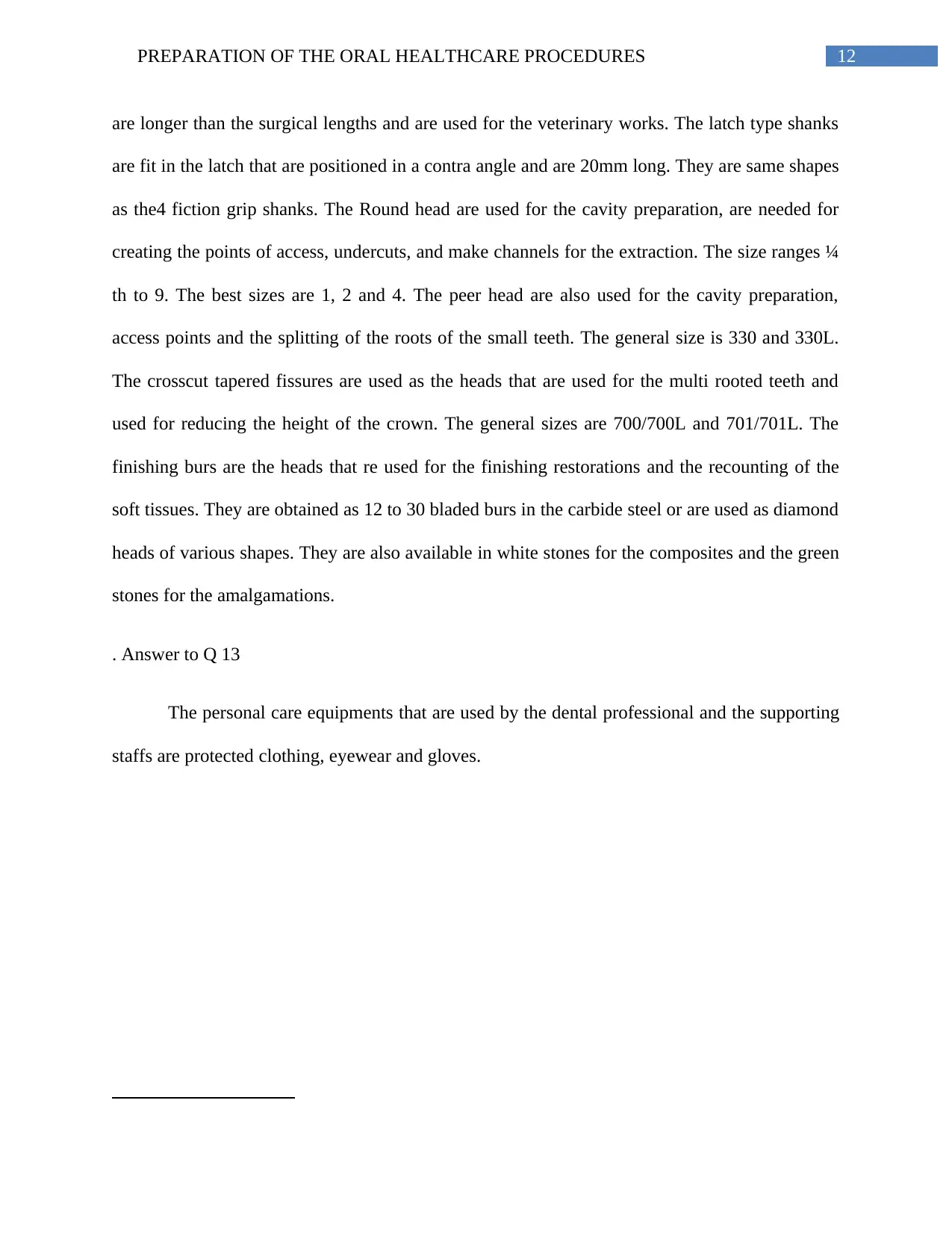
12PREPARATION OF THE ORAL HEALTHCARE PROCEDURES
are longer than the surgical lengths and are used for the veterinary works. The latch type shanks
are fit in the latch that are positioned in a contra angle and are 20mm long. They are same shapes
as the4 fiction grip shanks. The Round head are used for the cavity preparation, are needed for
creating the points of access, undercuts, and make channels for the extraction. The size ranges ¼
th to 9. The best sizes are 1, 2 and 4. The peer head are also used for the cavity preparation,
access points and the splitting of the roots of the small teeth. The general size is 330 and 330L.
The crosscut tapered fissures are used as the heads that are used for the multi rooted teeth and
used for reducing the height of the crown. The general sizes are 700/700L and 701/701L. The
finishing burs are the heads that re used for the finishing restorations and the recounting of the
soft tissues. They are obtained as 12 to 30 bladed burs in the carbide steel or are used as diamond
heads of various shapes. They are also available in white stones for the composites and the green
stones for the amalgamations.
. Answer to Q 13
The personal care equipments that are used by the dental professional and the supporting
staffs are protected clothing, eyewear and gloves.
are longer than the surgical lengths and are used for the veterinary works. The latch type shanks
are fit in the latch that are positioned in a contra angle and are 20mm long. They are same shapes
as the4 fiction grip shanks. The Round head are used for the cavity preparation, are needed for
creating the points of access, undercuts, and make channels for the extraction. The size ranges ¼
th to 9. The best sizes are 1, 2 and 4. The peer head are also used for the cavity preparation,
access points and the splitting of the roots of the small teeth. The general size is 330 and 330L.
The crosscut tapered fissures are used as the heads that are used for the multi rooted teeth and
used for reducing the height of the crown. The general sizes are 700/700L and 701/701L. The
finishing burs are the heads that re used for the finishing restorations and the recounting of the
soft tissues. They are obtained as 12 to 30 bladed burs in the carbide steel or are used as diamond
heads of various shapes. They are also available in white stones for the composites and the green
stones for the amalgamations.
. Answer to Q 13
The personal care equipments that are used by the dental professional and the supporting
staffs are protected clothing, eyewear and gloves.
Paraphrase This Document
Need a fresh take? Get an instant paraphrase of this document with our AI Paraphraser
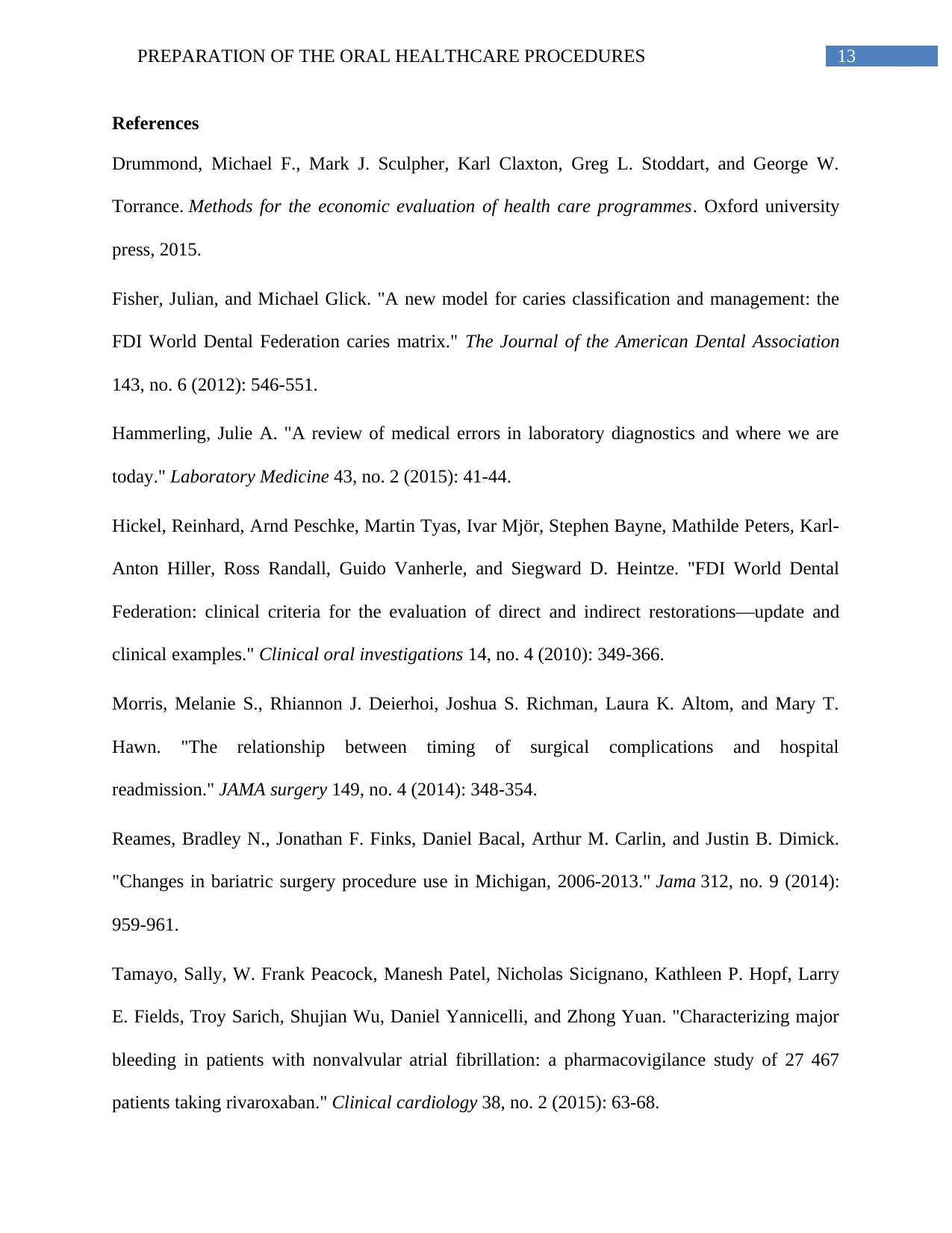
13PREPARATION OF THE ORAL HEALTHCARE PROCEDURES
References
Drummond, Michael F., Mark J. Sculpher, Karl Claxton, Greg L. Stoddart, and George W.
Torrance. Methods for the economic evaluation of health care programmes. Oxford university
press, 2015.
Fisher, Julian, and Michael Glick. "A new model for caries classification and management: the
FDI World Dental Federation caries matrix." The Journal of the American Dental Association
143, no. 6 (2012): 546-551.
Hammerling, Julie A. "A review of medical errors in laboratory diagnostics and where we are
today." Laboratory Medicine 43, no. 2 (2015): 41-44.
Hickel, Reinhard, Arnd Peschke, Martin Tyas, Ivar Mjör, Stephen Bayne, Mathilde Peters, Karl-
Anton Hiller, Ross Randall, Guido Vanherle, and Siegward D. Heintze. "FDI World Dental
Federation: clinical criteria for the evaluation of direct and indirect restorations—update and
clinical examples." Clinical oral investigations 14, no. 4 (2010): 349-366.
Morris, Melanie S., Rhiannon J. Deierhoi, Joshua S. Richman, Laura K. Altom, and Mary T.
Hawn. "The relationship between timing of surgical complications and hospital
readmission." JAMA surgery 149, no. 4 (2014): 348-354.
Reames, Bradley N., Jonathan F. Finks, Daniel Bacal, Arthur M. Carlin, and Justin B. Dimick.
"Changes in bariatric surgery procedure use in Michigan, 2006-2013." Jama 312, no. 9 (2014):
959-961.
Tamayo, Sally, W. Frank Peacock, Manesh Patel, Nicholas Sicignano, Kathleen P. Hopf, Larry
E. Fields, Troy Sarich, Shujian Wu, Daniel Yannicelli, and Zhong Yuan. "Characterizing major
bleeding in patients with nonvalvular atrial fibrillation: a pharmacovigilance study of 27 467
patients taking rivaroxaban." Clinical cardiology 38, no. 2 (2015): 63-68.
References
Drummond, Michael F., Mark J. Sculpher, Karl Claxton, Greg L. Stoddart, and George W.
Torrance. Methods for the economic evaluation of health care programmes. Oxford university
press, 2015.
Fisher, Julian, and Michael Glick. "A new model for caries classification and management: the
FDI World Dental Federation caries matrix." The Journal of the American Dental Association
143, no. 6 (2012): 546-551.
Hammerling, Julie A. "A review of medical errors in laboratory diagnostics and where we are
today." Laboratory Medicine 43, no. 2 (2015): 41-44.
Hickel, Reinhard, Arnd Peschke, Martin Tyas, Ivar Mjör, Stephen Bayne, Mathilde Peters, Karl-
Anton Hiller, Ross Randall, Guido Vanherle, and Siegward D. Heintze. "FDI World Dental
Federation: clinical criteria for the evaluation of direct and indirect restorations—update and
clinical examples." Clinical oral investigations 14, no. 4 (2010): 349-366.
Morris, Melanie S., Rhiannon J. Deierhoi, Joshua S. Richman, Laura K. Altom, and Mary T.
Hawn. "The relationship between timing of surgical complications and hospital
readmission." JAMA surgery 149, no. 4 (2014): 348-354.
Reames, Bradley N., Jonathan F. Finks, Daniel Bacal, Arthur M. Carlin, and Justin B. Dimick.
"Changes in bariatric surgery procedure use in Michigan, 2006-2013." Jama 312, no. 9 (2014):
959-961.
Tamayo, Sally, W. Frank Peacock, Manesh Patel, Nicholas Sicignano, Kathleen P. Hopf, Larry
E. Fields, Troy Sarich, Shujian Wu, Daniel Yannicelli, and Zhong Yuan. "Characterizing major
bleeding in patients with nonvalvular atrial fibrillation: a pharmacovigilance study of 27 467
patients taking rivaroxaban." Clinical cardiology 38, no. 2 (2015): 63-68.
1 out of 14
Related Documents
Your All-in-One AI-Powered Toolkit for Academic Success.
+13062052269
info@desklib.com
Available 24*7 on WhatsApp / Email
![[object Object]](/_next/static/media/star-bottom.7253800d.svg)
Unlock your academic potential
© 2024 | Zucol Services PVT LTD | All rights reserved.




